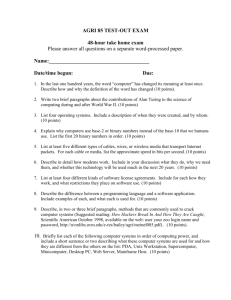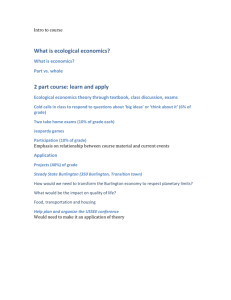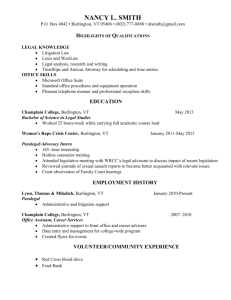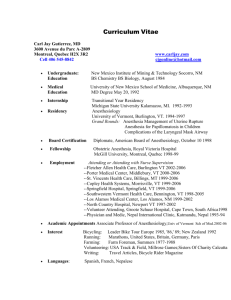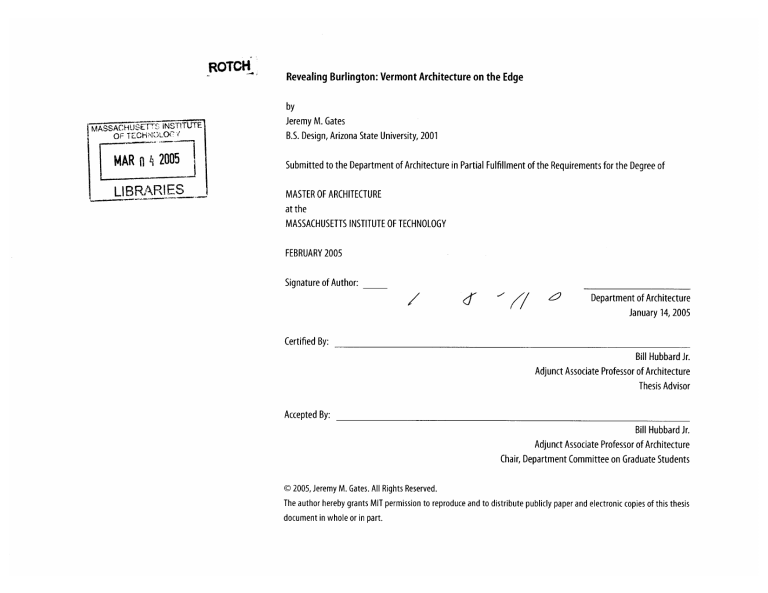
ROTCHO
Revealing Burlington: Vermont Architecture on the Edge
scTTS INSTITUE
to'
OF TECr
Jeremy M.Gates
B.S. Design, Arizona State University, 2001
MAR n h 2005
Submitted to the Department of Architecture in Partial Fulfillment of the Requirements for the Degree of
LIRARIE
MASTER OF ARCHITECTURE
at the
MASSACHUSETTS INSTITUTE OF TECHNOLOGY
FEBRUARY 2005
Signature of Author:
4~
/
Department of Architecture
January 14, 2005
Certified By:
Bill Hubbard Jr.
Adjunct Associate Professor of Architecture
Thesis Advisor
Accepted By:
Bill Hubbard Jr.
Adjunct Associate Professor of Architecture
Chair, Department Committee on Graduate Students
© 2005,
Jeremy M.Gates. All Rights Reserved.
The author hereby grants MIT permission to reproduce and to distribute publicly paper and electronic copies of this thesis
document inwhole or inpart.
-- - - I
THESIS COMMITTEE:
Advisor:
Bill Hubbard Jr.
Adjunct Associate Professor of Architecture
Readers:
Carol Burns
Visiting Associate Professor of Architecture
Christopher Dewart
Technical Instructor, Department of Architecture
Revealing Burlington: Vermont Architecture on the Edge
by
Jeremy M.Gates
Submitted to the Department of Architecture on January 14, 2005 in Partial Fulfillment of the Requirements for
the Degree of Master of Architecture
ABSTRACT
This project explores building inthe most urban environment of astate that identifies with its ruralness. The site,
located at the top of asteep bluff inBurlington at the edge between the city's downtown core and its waterfront,
calls for aresponse to the urban forces that are present. Creating aconnection between the city and the waterfront,
and responding to the city grid, the shape of the land, and the adjacent park were central goals of the project.
With these objectives in place, I looked to rural sources to establish aset of criteria for judging the architectural
design moves. I began by looking at the rural typology of the barn for its simple and continuous membrane, use of
materials that record the building's age, structure that iscompletely revealed and inhabited, the purely functional
plan, and the way it addresses the landscape. The project later drew upon other aspects of 'Vermontness' such
as the steeple as amarker inthe landscape and the quarry's geometric cuts inthe earth. The design uses these
criteria together with the site specific urban objectives to create aproject that both embodies the identity of the
state of Vermont and reveals important aspects of the city and the site.
Thesis Advisor: Bill Hubbard Jr.
Title: Adjunct Associate Professor of Architecture
3
ACKNOWLEDGEMENTS
To Jessica, your constant love and support through these years isthe reason I
have made it here today. I am extremely grateful to have you by my side.
Aspecial thank you to my advisor, Bill Hubbard. Your inspiration, enthusiasm,
encouragement, and dedication from the beginning of this process made it a
truly rewarding experience.
Thank you to my readers, Carol Burns and Chris Dewart, for providing tremendous insight at key points along the way.
Thank you to all of my friends and family for being there to encourage me, and
for always believing that I could reach my goals.
TABLE OF CONTENTS
1. Introduction to Burlington
and its waterfront
6
II. Introduction to the project site
10
Ill. Urban Objectives
16
IV. Design Criteria
18
V. Program
22
VI. Project Design
24
VI. Conclusion
43
Figure 1
Burlington, Vermont
from the lake.
Figure 2
Atypical Vermont village
Island Pond, Vermont
1. Introduction to Burlington and its Waterfront
The state of Vermont's cultural identity isone that isfar
from urban. The rolling green mountains and valleys
sprinkled with small farms and villages are what create
the state's image. The commercial, residential, and cultural
center ofthe state, however, isclearly the city of Burlington.
Chittenden County, with Burlington at its center, accounts
for approximately 25% of Vermont's population. The city,
while small, isadense and alive urban environment.
Downtown Burlington isthe center of activity not
only for the area, but for the entire state. Bustling Church
Street, apedestrian street which spans the downtown core,
ispacked with restaurants, bars, cafes, retail shops, and
cart vendors, with City Hall at one end of the street and a
Unitarian Church at the other (see figure 3). The surrounding blocks, in addition to more small businesses spilling
out from Church Street, house various branches of both
the local and state government, as well as private office
buildings and several churches. Afew blocks up the hill
to the east sits the historic campus of the University of
Vermont, with astudent population of over 10,000.
Perhaps Burlington's greatest asset isits location.
The city sits on abluff along the eastern shore of Lake
Champlain, with atremendous view across the lake to New
York's Adirondack Mountains beyond. Though Burlington's
downtown core has flourished for decades, the city has
only recently begun to take advantage of its expansive
waterfront.
Burlington's waterfront has arich history. During the
war of 1812, it was the site of amilitary base and major
military hospital. The base spanned an area of several
blocks around a Battery, where Battery Park islocated
today. From this site inAugust of 1813, British forces were
successfully kept at bay inashort exchange of cannon fire.
During the war, Burlington was also the home of the United
States Fleet on Lake Champlain. In1814 Burlington was the
staging ground for several unsuccessful attacks against
Canada, but later that year, troops once stationed in Burlington achieved an important victory against the British in
Plattsburgh, New York. By 1817, the very poorly constructed
base was completely abandoned.
In 1823, the Lake Champlain Canal was opened,
providing acontinuous water route from New York City to
Montreal. This sparked rapid growth of the city, and the by
1850's Burlington had become the third largest lumber port
inthe world. The arrival of the Central Vermont Railroad in
1862 caused the start of the dairy industry, which continued
the city's growth. By the 1890's, the railroad had increased
the importance of Burlington's waterfront, as amajor transportation hub for both boat and rail between Montreal and
New York. By the mid 1920's, the automobile had become
widespread and the interstate highway was completed,
causing the city to turn its back on the no longer important
waterfront. The automobile was so loved that the city celebrated the abandonment of its streetcar service in 1929
by burning atrolley car in the center of downtown. The
waterfront was transformed into an area for fuel storage.
By the 1970's, with the fuel storage necessity passed, the
waterfront had been almost completely abandoned, left
with asprinkling of unused industrial remnants.
Figure 3
Church Street, Burlington
Figure 4
New England density chart
Bur ingto
1853
Burlington isthe third largest lumber port in
the world.
1890
The waterfront isthe transportation center
of the state, an important hub between New
York and Montreal.
1926
With the advent of the automobile and
highway, the city turns its back on the
highway and uses itfor fuel storage.
1978
The waterfront isalmost completely
abandoned.
Figure 5
History of the Burlington Waterfront
I
Over the last century, numerous development
proposals for the Burlington waterfront have failed. The
main reason for this isthat architects and developers have
presented development ideas that Vermont residents could
not relate to. In1990, Burlington voters passed a"Waterfront Revitalization Plan," created by the city with the hope
of finally reclaiming this valuable asset. Major components
of this plan have since been completed, including an 11
acre urban park, an $11.5 million Lake Champlain Basin
Science Center, and improved pedestrian, automobile and
bicycle access.
The current owners of nearly all of the developable land
on the Burlington waterfront have realized the mistakes of
the past. After an extensive analysis of both the history of
the area and of the architecture of Vermont villages, they
have just recently set in motion anew, quite promising,
twenty-five year development masterplan that has been
met with great approval. This plan intends to introduce a
"neighborhood" of small-scale, mixed use, office, retail, entertainment and residential development that will ensure
year-round, day and night activity on the waterfront. The
plan also includes the introduction of aMulti-Modal Transportation Center on the site of the historic train station,
making the waterfront the major transportation hub for the
area once again. Some of the initial pieces of this project
have been completed, and another major component is
under construction.
Figure 6
25 Year waterfront masterplan
Figure 7
10
Figure 8
II. Introduction to the Project Site
The specific site for my proposal islocated at the edge
between the waterfront and the city, in a key location
to act as acatalyst for connection between the two. The
shape of the waterfront isdefined by asteep bluff, with an
elevation change of approximately 100'at its highest. This
landform, while creating breathtaking views from Battery
Park at its top, it also creates a barrier between the city
and the waterfront.
Four major streets run from downtown to the waterfront, and define the downtown core. The project site
sits between the two northern streets. Pearl Street, the
northernmost of these major connections, and the northern
edge of the downtown core, isnot only an important connection to downtown, but extends to connect to the University of Vermont, and acts as one of two major connections
from the neighboring cities. Church Street, the pedestrian
mall that isthe current center of activity, runs north/south
between these streets (see figure 7). From the waterfront,
there isno indication of the streets above.
The site isalso located at the meeting point of two
clashing grids within the city. Running parallel to the shape
of the bluff the city rests on, the neighborhood north of
the downtown core shifts to ageometry different from the
one defined by downtown (see figure 8). This geometry is
clearly expressed inthe major path that runs diagonally
through Battery Park.
The site issandwiched between the two major public
park spaces of Burlington. Battery Park, the historic park
located at the top of the bluff overlooking the waterfront is
located to the north ofthe site, but also extends to create a
tree-lined pedestrian path running down the hill from the
park to College Street. The second isthe newer park below
the bluff at the water's edge, one of the first elements of
the city's plan for redevelopment (see figure 9).
With all of these urban forces coming together at one
key point, the site seemed magnetic. Itisan important yet
unresolved place within the city of Burlington that was
perfect for the exploration of this thesis.
Figure 9
-A-
m.B
m
Figure 12
Site context
-- - - - - - - - - - - - - - - -- -- - -
Figure 13
Examples of surrounding buildings
Ill. Urban Objectives
After careful analysis of the city and the selected site, I
was able to arrive at aset of objectives that would not
only help to determine the scope of the project, but would
act as the central guidelines for shaping the project at the
urban scale.
16
3. Expose the bluff and make it and extension of the
park
Though the overgrown bluff acts as aphysical and visual
barrier, it isnearly impossible to have asense of the dramatic
elevation change or the shape of the land from either the
top or the bottom. Another goal was to cut into the bluff
1. Create an additional physical connection between and expose it, which would not only allow for aclearer
the city and the waterfront
sense of the elevation change and shape of the landform,
The most obvious reason for the disconnect between the but would also make the slope of the bluff habitable land,
city and the waterfront isthe physical barrier created by an extension of the park that takes advantage of the views
the steep bluff. Currently there isonly one access point out over the waterfront, Lake Champlain, and the Adironto the waterfront (at the base of College Street), which is dack mountains beyond.
often packed with both pedestrian and vehicular traffic.
One goal of the project was to create an alternative path 4. Address the converging geometries
closer to the northern edge of downtown and Battery Park, As was shown earlier, the site isat apoint of converging
which allows pedestrians to negotiate the elevation change city geometries. Afourth urban objective isto receive these
created by the bluff and to move between the waterfront geometries into the project, and address this important
and the city.
point where they come together.
2. Create visual connections between the city and the
waterfront
Inaddition to the physical barrier, there isalso aclear visual
disconnect between the waterfront and the city. My goal
was for the project to mark the city grid, creating astronger
visual connection between the city and the waterfront, and
creating agreater sense of place within the city while at
the water's edge.
Figure 14
View over the waterfront
from Battery Park
Figure 15
Panorama of Battery Park
Figure 16
Looking toward the bluff
Figure 17
IV. Design Criteria
Inaddition to the objectives that inform the design at the
urban scale, amain goal from the beginning of the project
was to establish aset of architectural design criteria that
were drawn from the cultural identity of Vermont. These
would help to judge the design decisions that were made
throughout the process. Since Vermont's identity isvery
must based on its ruralness, I looked to rural Vermont to
search for principles which could be applied to abuilding
inan urban setting. I was first drawn to the rural typology
of the barn, and after some study, I was able to define
aset of five design criteria that I could use to inform my
architectural design process.
18
1. Membrane enclosure
Though the material may shift from the roof to the walls,
the barn can be identified by an uninterrupted membrane
which covers the entire structure, and remains constant
despite any of the changes that may be happening within.
2. Materials
Inearly times, for the sake of economy and practicality,
barns were constructed using materials that were local to
the site, usually consisting of wood and stone. The use of
these materials creates an inherent connection to the site.
These materials by nature also record the building's age,
and only improve aesthetically as time passes.
3. Structure
Incontrast with the membrane enclosure, abarn's structure
isalmost always completely exposed, visible, and inhabitable. The structural order isclearly expressed, with varied
layers of space created within the larger structure.
Figure 18
19
Figure 19
Figure 20
4. Plan and Functionality
The beauty of barn plans isthat they are almost always
purely functional and coincide quite closely with the structural order. This allows for asimple and clear layout of the
spaces and circulation. Acommon feature of many barn
plans isthe wide aisle that runs through the center, for ease
of movement through the building.
20
Figure 21
5. Address of the Landscape
Most barns have aclose relationship with the surrounding landscape, and often allow the landscape to pass into
and through the structure. Due to the nature of my site I
especially looked at the bank barn, which uses stone walls
to hold back the slope on two or three sides, creating a
habitable lower level. Alighter structure defines the other
sides, the upper level, and the roof.
As the initial design ideas began to take shape, my process
lead me to look beyond the typology of the barn to other
aspects of'Vermontness'that could inform the project. This
study added two additional points to my design criteria.
Figure 22
6. The Quarry
Infinding away to deal with the steep slope of the site, I
looked to the geometric cuts made by the Vermont quarry,
creating walls of stone. This inspired the way I handled the
incisions that I made inthe Burlington bluff.
21
7. The Church Steeple
My design intention was to not only mark the city grid but
to act as amarker in the landscape of the city. This was
inspired by looking at the way the church steeple isthe
recognizable landmark inthe typical Vermont village.
Figure23
Figure 24
Fleming Museum
University of Vermont
V. Program
The site I have chosen has extreme prominence due its
proximity to both downtown and the waterfront, its visibility from the city and especially from the water, and its
location adjacent to the major public park spaces in the
city. Because of this my aim was to find aprogram that was
civic in nature and extremely accessible to the public, but
that would also allow for the exploration of both my urban
objectives and my architectural design criteria.
Burlington's Waterfront Revitalization Plan, updated in
1998, discussed tentative plans for the reuse of the Moran
Generating Station, an abandoned power station present
on the northern end of Burlington's Waterfront, as contemporary art facility. While these plans were never carried out,
replaced by the most recent plan to relocate the Burlington YMCA to this building, they did express the need for a
facility that the city currently lacks. The plans were raised
by the Fleming Museum, the art museum of the University
of Vermont. The plan states the need for a building with
"large open spaces that can accommodate very large scale
work and can be reconfigured as needed."
This program isappropriate for the site for anumber
of reasons. First, this type of building meets the civic and
public requirements that I was searching for. Itisthe perfect
building type for adjacency to public park space. Second an
art gallery of this type acts as one of the city's main attractions, and seems to call for avisibility and prominence that
it would not have received at the Moran Plant. Third, my
desire to connect with the city isstrengthened with this
program, adding aconnection to the University as well as
the general public. The Fleming Museum islocated along
Pearl Street, which ends directly at my site. Fourth, the
program allows for the incorporation of alarge sculpture
garden, which provides an expansive landscape element to
the project, following with my desires to create habitable
outdoor space along the bluff as an extension of the park.
Lastly, this building type provides enough flexibility to
allow for the exploration of both the urban and architectural objectives stated earlier.
The program consists of:
a. Alarge gallery space with filtered light and movable
partitions which allows for frequently rotating contemporary art exhibitions.
b. An auditorium seating approximately 250 persons for
lectures associated with the museum as well as other
public and university events.
c. Reception and area and cafe kiosk to service museum
patrons.
d. Museum store selling products related to the museum
and its exhibitions.
e. Office space, break room, and conference rooms,
separated from the main building for use by administrative staff.
f. Loading dock and small storage area for delivery and
removal of exhibitions.
g. Public restrooms and coatroom.
h. Alarge outdoor sculpture garden consisting of four
terraces spanning an entire city block which acts as
public outdoor space with views over the water.
i. An outdoor pavilion which acts as asecond entrance
to the museum and sculpture garden, and provides
circulation for the terraces.
Figure 25
23
Figure 26
-a
slie #ihiex
..
-- U
25
IV. PROJECT DESIGN
Figure 27
Site Plan
27
Figure 28
View of the project inthe
surrounding context
Key Project Views
Figure 29
View from Lake Champlain and the waterfront
From this view the buildings have a strong verticality,
appearing as towers rising out of the bluff. The project
acts as alandmark for the city, much like the church steeple
inthe small Vermont village. The buildings also mark the
city streets beyond, creating astronger visual connection
between the waterfront and the city. The terraces appear
as a'white gash'in the slope, much like aquarry, exposing
the shape of the bluff and the dramatic elevation change.
28
Figure 30
View from the city
As one approaches from up the hill on Pearl Street, the
museum has an urban presence at the end of the street,
while at the same time remaining very much inscale with
the surrounding buildings. The building from this side isa
glass display case, which draws people to it,but also allows
framed views through itto the water beyond.
N
View from the park
Figure 31
From Battery Park, the administrative building isin the
foreground, taking on the angled geometry of the park
and looking out over it. The large retaining wall with the
museum behind shoots out from the slope toward the
water.
29
Figure 32
Project Layers
1. Retaining Walls
The stone walls of the project appear as quarry-like cuts
inthe slope. The main retaining wall grows in height as it
follows the slope of Battery Street and the bluff, reaching
its maximum height to define the lower level of the
museum. This wall acts very much like the stone walls
of the bank barn, holding back the earth on two sides to
create ahabitable lower level inthe earth. The secondary
terrace walls define the outdoor space, and also define the
fall of the auditorium and set up arhythm for the main
building structure to grow out of.
30
Figure 33
2. Structure
Using the spacing defined by the terrace walls, four structural bays create the building frame. This frame provides
support for the heavy loads created by the gallery. As ina
barn, the structural system iscompletely clear, and remains
visible throughout the building.
3. Gallery Volume
The gallery space consists of aconcrete tray that spans
between the structural framework and cantilevers out past
the frame at its ends. The tray acts not only as the floor, but
turns up to become the display walls of the gallery. Above
this tray, atranslucent glass skin filters both the natural and
artificial light and prevents shadows, creating aconsistent
glow within the gallery.
Figure 34
31
4. Membrane Structure
This secondary layer of structure provides support for the
outer skin ofthe building, including the roof structure. Since
the main structural loads are supported by the larger frame,
this layer ismade up of lighter members which break up
the larger bays.
Figure 35
Figure 36
5. Membrane
Again inspired by the barn, acontinuous membrane wraps
the outside of the building structure. Though this skin is
uninterrupted, it changes innature as it wraps the building.
On the north side of the structure, the membrane ismostly
transparent to let inthe desirable north light. As it moves
to the roof, it becomes completely opaque to allow for insulation inthis cold climate. Wrapping around to the south
side, the membrane becomes aseries of wood louvers that
provide shade from the strong southern sun.
32
Figure 37
6. Slots of space
Space between the structural frame and the gallery volume
create space for circulation through the building. From the
street, the museum patrons enter through this slot of space,
and experience being between the frame and the gallery,
looking through the entire building structure and out to
the water before entering the gallery. The slot opposite
the entry holds alarge glass elevator and astair to move
down to the auditorium level and up to the level of the
administrative building.
Figure 39
Auditorium level plan
Pavilion circulation plan (below)
Figure 40
Section through gallery and auditorium
Figure 41
Gallery / Mezzanine level plan
Office level plan (below)
Figure 42
Section through terraces
Figure 44
View of the gallery building from
the south side
Figure 43
(left)
Overall view of the project
Figure 45
View of the gallery and service
building from the north
Figure 46
(left)
Detail view of the building structure
Figure 47
View of the west side of the building
looking through the space
Figure 49
The gallery volume pulled out from
the structure
Figure 48
(left)
View from inside the gallery
Figure 50
View from inside the auditorium
*4j APING0
4oAk
t4l
4M4
MAW
I3
-
i
R -,
Lk4c*
ealwe
RIACa
(HaXWOr)
T~fr~
2A~Y &t4q
Tho4
7IOA IPd \Apt-w4Ak
wT ..
77......
;-1 4$
j_
A.
o eL
4{t
t
CetPAy
on
%-TI i
QUA
4aYEL
Iv
de4
retf
*RrA 1U146P
l~
"Te
rR.
ONAWN-0-040,
VIll. Conclusion
This thesis project began with acity and achallenging site,
and with amultifaceted set of urbanistic and architectural
goals. The result isasolution that improves the city's connection to its waterfront and reveals important aspects of
the city and the specific site, giving both the resident and
the visitor abetter understanding of the place. The program
fills aspecific need for the city and the university, creates a
landmark and destination within the Burlington cityscape,
and provides asignificant extension of the city's outdoor
public space. Though the solution isquite site specific, the
design provides an example of an urban architecture that
comes out of the rural identity of the state, drawing inspiration from places that Vermont residents can relate
to. It shows that it ispossible to draw from these sources
without literally transposing them, resulting inadesign
that isnot traditional but still maintains afamiliarity that is
appropriate inthis setting. This design would act as catalyst
inthe development of an area of Burlington with avery
promising future.
43
BIBLIOGRAPHY
Albers, Jan. Hands on the Land: AHistory of the Vermont Landscape. Cambridge: MIT Press, 2000.
Arthur, Eric and Dudley Witney. The Barn: AVanishing Landmark in North America. Ontario: Company Limited, 1972.
City of Burlington Vermont Community and Economic Development, Waterfront Revitalization Plan. <http://www.cedoburlington.org/waterfront/watrevtoc.htm>
Heynen, Jim. Harker's Barns: Visions of an American Icon. Iowa City: University of Iowa Press, 2003.
Liebs, Chester H.The Burlington Book: Architecture, History, Future. Burlington, Vermont: University of Vermont Historic Preservation Program, 1980.
Main Street Landing Company. "Historical Photos." <http://www.mainstreetlanding.com/projects/photos-historical.php>
Millard, James P."Burlington Vermont During the War of 1812." <http://www.historiclakes.org/explore/burlington.htm>
Radford, William. Practical Plans for Barns, Carriage Houses, Stables, and Othe Country Buildings. Stockbridge, Massachusetts: The Berkshire Traveller Press, 1978.
Vlach, John Michael. Barns. New York: W.W. Norton &Company, 2003.
Wikipedia, The Free Encyclopedia. "Burlington, Vermont." <http://en.wikipedia.org/wiki/Burlington,_Vermont>
LIST OF ILLUSTRATIONS
*All photos and illustrations were created by the author unless noted below.
Figure 1
Photo by Robert Lyons Photography. Retrieved from <http://www.robertlyonsphotography.com/burlington-waterfront.htm>.
Figure 2
From Hands on the Land: AHistory of the Vermont Landscape page 130.
Figure 4
From "Census Snapshot: Population Density" by Julia McCue, of MainToday.com. Retrieved from
<http://www.mainetoday.com/census2000/news/010430nedensity.shtml>.
Figure 5
Images from Main Street Landing Company, Burlington, VT. Retrieved from <http://www.mainstreetlanding.com/projects/photos-historical.php>.
Figure 6
Image from Main Street Landing Company, Burlington, VT. Retrieved from <http://www.mainstreetlanding.com/projects/25yearplan.php>.
Figure 17 From Harker's Barns: Visions of an American Icon page 45.
45
Figure 18 From The Barn: AVanishing Landmark inNorth America page 178.
Figure 19 From Harker's Barns: Visions of an American Icon page 17.
Figure 20 From Practical Plans for Barns, Carriage Houses, Stables, &Other Country Buildings, page 110.
Figure 21 Image from The Foundation for Historic Building Rescue, Inc. Retrieved from <http://mahoneyfamily.org/fhbr/bernvillebarn.html>.
Figure 22
Photo by Lee K.Marriner. Retrieved from <http://www.photojournalistas.com/FebMar_2003/GraniteCapital/photo-pages/quarryview.html>.
Figure 23
Photo by Kimberly R.Greeno. Retrieved from <http://www.visionsofvermont.com/gaIleries/autumn/14a.htm>.
Figure 24
Image from the University of Vermont. Retrieved from <http://www.uvm.edu/-fleming/smarty/templates/press/museumimage.html>.
Figure 25
Image from GalleryGuide.org. Retrieved from <http://www.galeryguide.org/2004-02/editorials/nyOO4.asp>.
Figure 26
Photo by Lars Baumer. Retrieved from <http://www.mathematik.uni-bielefeld.de/-baeumer/usa/page.html.

